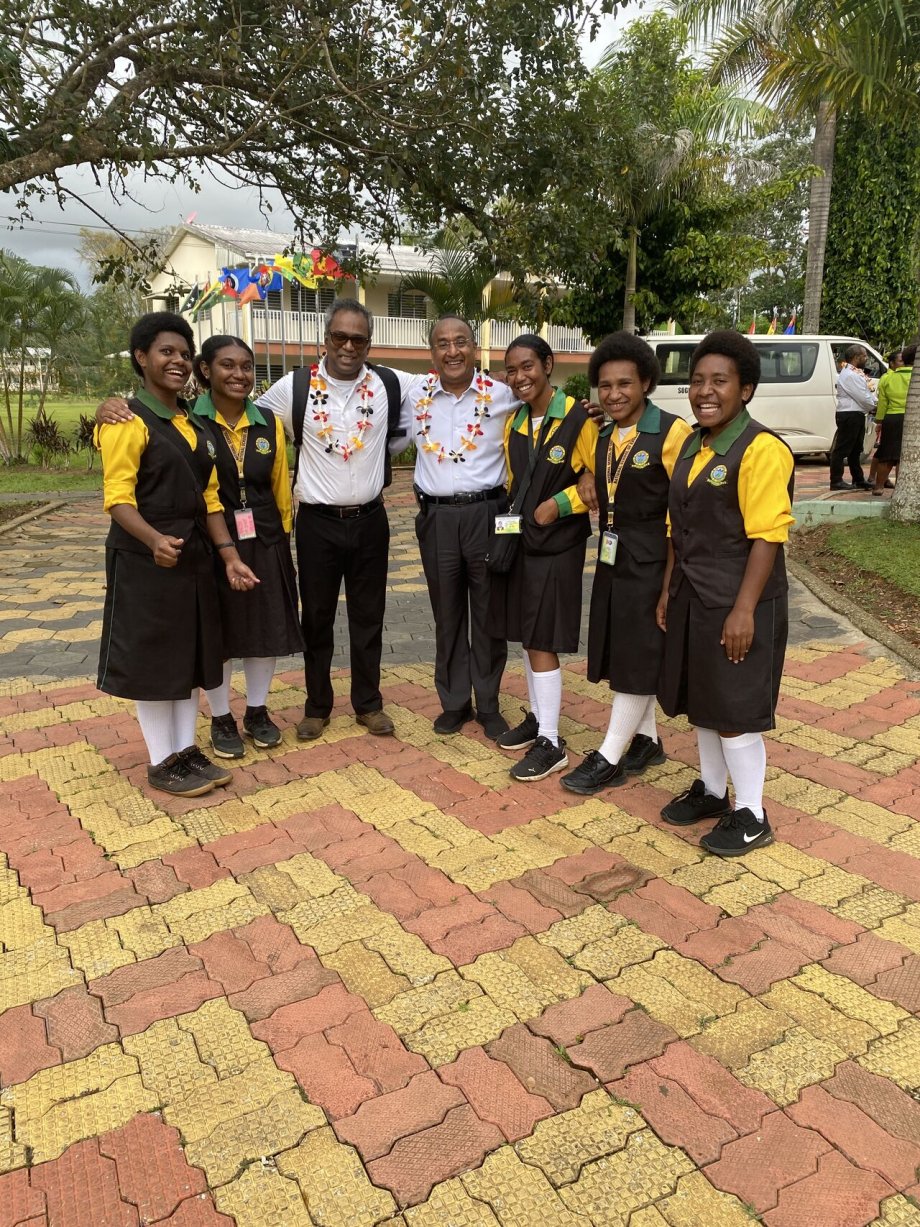
Sixteen time zones, 8,000 miles and, culturally, a whole other world away, Papua New Guinea sits in the tropical Asian Pacific.
It’s so far removed from the mindset of Northern Plains dwellers that even Rajesh Kavasseri, an experienced world traveler, had to look up Papua New Guinea on the map before he and three other South Dakota State University officials made the weeklong trip this fall.
Kavasseri, associate dean for research in the Jerome J. Lohr College of Engineering, traveled with Dean Sanjeev Kumar. They were met there by Jon Stauff, assistant vice president for international affairs, and joined a day later by Matt Miller, a chemistry professor and assistant head of the Department of Chemistry and Biochemistry.
With 5,000 kilometers of coastline, a 14,000-foot volcanic mountain and lush vegetation, Papua New Guinea is a tourist’s paradise. They weren’t there for that. Rather, the SDSU team was visiting the former Australian colony to explore educational connections in the island country of 10 million people that didn’t gain its first university until 1965.
While its estimated literacy rate was 64% in 2015, the country’s current government is putting an emphasis on increasing its STEM-trained populace.
Thirty Papua New Guinea students here now
In fact, SDSU welcomed 30 Papua New Guinea freshmen at the start of classes this fall and more than two-thirds of them joined the Jerome J. Lohr College of Engineering.
They were invited with other international students to attend a welcome-to-SDSU ice cream social before classes began Aug. 21. It was also attended by numerous SDSU faculty and administrators, local businesses, police and fire officials, and representatives from the Papua New Guinea Department of Education.
Following a time of cordial socializing at Good Roots Farm and Gardens just north of campus, the Papua New Guinea officials invited the SDSU team to visit Papua New Guinea to learn more about the Papua New Guinea education systems, meet key officials and explore more collaborative opportunities there.
A three-day journey to Papua New Guinea
Hence, at 3:15 a.m. Oct. 27, Kumar sent a text to Kavasseri to see if he was ready to begin their journey. Three days later, 5 a.m. Oct. 30, they landed in the capital city of Port Moresby, Papua New Guinea. An exhausting journey it was, but what they saw and learned in the next four days put energy in their steps.
“It was heartening to see Papua New Guinea strengthening their STEM background,” Kavasseri said. Kumar added, "SDSU and Papua New Guinea appears to have a perfect match to collaborate to help Papua New Guinea build its STEM capacity.”
Most of their time was spent with national education officials. However, they also met with high school students and the island country’s prime minister. Each meeting was equally informative and inspiring, Kavasseri said.
SDSU officials meet with prime minister
The meeting with Prime Minister James Marape was a pleasant surprise. A formal dinner was planned with the prime minister at the Hilton, but other priorities arose, and the dinner had to be canceled. However, Marape wanted to make sure he had a chance to welcome the SDSU team and speak to the group, even though it was brief.
“He extended his gratitude that SDSU is taking care of the Papua New Guinea students. He considers them as his kids. He wanted to reciprocate that hospitality,” Kavasseri said.
Papua New Guinea has designated six national schools of excellence for STEM education. The SDSU delegation met a group of teachers and students at the Port Moresby National School of Excellence and had an open town hall assembly at Sogeri National School of Excellence. Several hundred students were present.
“They were excited. We told them why their future should look blue and yellow. They had stars in their eyes,” Kavasseri said.
Cooperative research also discussed
The current SDSU Papua New Guinea students will soon be completing their first semester, providing the first solid check on how they fared in a completely different environment. “They are used to doing everything on paper and pencil. These are smart students but have a good learning curve to adjust culturally to the U.S. environment,” Kavasseri said.
Kavasseri considered it a very valuable trip, meeting with Papua New Guinea officials, who are “very glad to partner with SDSU. They see SDSU as a great instrument to fulfill their vision of institutional growth.”
In addition, the SDSU group met with officials from five colleges. The long discussion included ways in which the schools could engage in research with State. Because “many parts of the country are untouched by civilization,” it would serve as good testing grounds for topics such as sustainability and climate change, Kavasseri said.
There also was a meeting with officials from the U.S. Embassy, which handles all the paperwork for the students as well as providing programming for students making the transition from the coastal tropics to the Northern Great Plains.
Another group of students is expected to arrive in the fall, and a follow-up visit by SDSU officials is expected in about a year, Kavasseri said.
Editor’s note: The spring issue of Impulse, the college’s biannual printed magazine, will include an article about the current students’ experiences at SDSU and Brookings.
- Contact:
- Telephone number: 605-688-4538
Republishing
You may republish SDSU News Center articles for free, online or in print. Questions? Contact us at sdsu.news@sdstate.edu or 605-688-6161.

